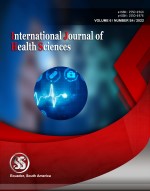Comparative study between true umbilical versus supra umbilical technique as an open access for pneumoperitoneum during laparoscopic surgery
Keywords:
True umbilical, Laparoscopy, Pneumoperitoneum, UmbilicusAbstract
Background: To start laparoscopic procedures, accessing the peritoneal cavity and establishing a carbon dioxide pneumoperitoneum are critical. The placement of the primary trocar is an important step in laparoscopic surgery. Many techniques have been reported in order to limit complications associated with the placement of the first trocar. In the study we describe a surgical method that offers quick, safe, and reliable preliminary entry into the peritoneal cavity with incredible functional and cosmetic results. Methods: A prospective randomised comparative study was conducted on 202 candidates for various laparoscopic surgery, comparing true umbilical versus supra umbilical open access for pneumoperitoneum from November 2021 to May 2022 in our surgical department. Results: There were 202 patients in the study, 109 (women) and 93 men. The port site entry per seconds was 41.3± 1.2 in true umbilical technique (group A) and 132.9± 5.5 in supra umbilical open technique (group B), and that was a statistically significant difference (p < 0.0001). There was a statistically significant difference in the mean time of port site wound closure (<0.0001) and port site gas leaking in the true umbilical access group compared to the supra umbilical access group (0.000161).
Downloads
References
De Azevedo O.C., Azevedo J.L.M.C., Sorbello A.A., Miguel G.P.S., Guindalini R.S.C. and De Godoy A.C. (2006). Veress needle insertion in the left hypochondrium in creation of the pneumoperitoneum. Acta Cir Bras., 21: 296-303.
Djokovic D., Gupta J. and Thomas V. (2016). Principles of safe laparoscopic entry. Eur J Obstet Gynecol Reprod Biol. ,201:179-188.
Imran M., Chohan M.Z., Mehmood Z., Mehmood K., Asif K. (2014). Comparison of Veress needle and direct trocar insertion in establishing pneumoperitoneum for laparoscopic cholecystectomy. Pakistan J Med Heal Sci. , 8: 652-654.
Krishnakumar S. and Tambe P. (2009). Entry complications in laparoscopic surgery. J. Gynecol Endosc Surg. 1: 4-11.
Lal P., Vindal A., Sharma R., Chander J. and Ramteke V.K. (2012). Safety of open technique for first-trocar placement in laparoscopic surgery: A series of 6,000 cases. Surg Endosc.,26:182-188.
Mah S. and Qsu A. (2019). Trans-Umbilical Open Port Placement During Laparoscopic Access : A Safe Technique.,15: 67-70.
Majeed F.A., Shabbir H., Rehman T., Nadeem M., Qamar-ul-haq C.M. (2020). Safety of hasson `s technique in laparoscopic cholecystectomy. 70:1465-1468.
Moberg A. C. Petersson U.. Montgomery A., (2007). An open Access technique to creAte pneumoperitoneum in lApAroscopic surgery Background : An open access technique might reduce severe vascular and visceral injuries . An open access technique through the umbilical cicatrix tube has been developed as a rou. 96: 297-300.
Neudecker J., Sauerland S., Neugebauer E. (2002). The European Association for Endoscopic Surgery clinical practice guideline on the pneumoperitoneum for laparoscopic surgery. Surg Endosc Other Interv Tech. 16:1121-1143.
Ogaick M. and Martel G. (2014). Advances in abdominal access for laparoscopic surgery: A review. Open Access Surg. ,7:81-88.
Perunovic R.M., Scepanovic R.P., Stevanovic P.D., Ceranic M.S. (2009). Complications during the establishment of laparoscopic pneumoperitoneum. J, Laparoendosc Adv, Surg, Tech. 19:1-6.
Pozzo R Arrangoiz R Cordera F. (2016). Trans umbilical laparoscopic access during laparoscopic procedures. Case Stud Surg. 3:1-5.
Purnomo, H., Apsari, A. E., & Hadyanawati, A. A. (2019). Quality of life, health and environment in older adults: Nursing house stress aging assessment. International Journal of Social Sciences and Humanities, 3(1), 134–142. https://doi.org/10.29332/ijssh.v3n1.272
Rakhmonov, O. M., Shadmanov, A. K., & Juraev, F. M. (2021). Results of endoscopic treatment of benign prostatic hyperplasia in patients with metabolic syndrome. International Journal of Health & Medical Sciences, 5(1), 21-25. https://doi.org/10.21744/ijhms.v5n1.1811
Resutra R., Mahajan N., Gupta R. (2019). Trans umbilical first trocar access during laparoscopic surgery. Int. J. Res. Med. Sci., 7:30-39.
Robinson J.K. and Isaacson K.B. (2005). Management Laparoscopic surgery in the obese : Safe techniques. Obg Manag. Published online 2005.
Sadhu S., Jahangir T.A., Sarkar S., Dubey S.K. and Roy M.K. (2009). Open port placement through the umbilical cicatrix. Indian J. Surg., 71: 273-275.
Sakamoto A., Kikuchi I. and Shimanuki H. (2017). Initial closed trocar entry for laparoscopic surgery: Technique, umbilical cosmesis, and patient satisfaction. Gynecol Minim Invasive Ther., 6:167-172.
Şentürk M.B., Doğan O., Polat M., Kılıçcı Ç., Pulatoğlu Ç., Tayyar A.T. (2018). Cosmetic outcomes of infraumbilical, supraumbilical, and transumbilical entry routes in laparoscopic surgery. Turkish J. Surg. 34: 290-294.
Shih S.L., Chen B.H. and Tam K.W. (2020). Transumbilical versus periumbilical incision for laparoscopic surgery: A meta-analysis. Am. J. Surg. ,220:1592-1598.
Suryasa, I. W., Rodríguez-Gámez, M., & Koldoris, T. (2021). Health and treatment of diabetes mellitus. International Journal of Health Sciences, 5(1), i-v. https://doi.org/10.53730/ijhs.v5n1.2864
Toro A., Mannino M., Cappello G., Di Stefano A., Di Carlo I. (2012). Comparison of two entry methods for laparoscopic port entry: Technical point of view. Diagn Ther Endosc. ,2012: 7.
Ulusoy S. (2018). Direct Trocar Entry For Laparoscopy Safety and Efficiency. Laparosc Endosc Surg Sci. 25: 64-66.
Published
How to Cite
Issue
Section
Copyright (c) 2022 International journal of health sciences

This work is licensed under a Creative Commons Attribution-NonCommercial-NoDerivatives 4.0 International License.
Articles published in the International Journal of Health Sciences (IJHS) are available under Creative Commons Attribution Non-Commercial No Derivatives Licence (CC BY-NC-ND 4.0). Authors retain copyright in their work and grant IJHS right of first publication under CC BY-NC-ND 4.0. Users have the right to read, download, copy, distribute, print, search, or link to the full texts of articles in this journal, and to use them for any other lawful purpose.
Articles published in IJHS can be copied, communicated and shared in their published form for non-commercial purposes provided full attribution is given to the author and the journal. Authors are able to enter into separate, additional contractual arrangements for the non-exclusive distribution of the journal's published version of the work (e.g., post it to an institutional repository or publish it in a book), with an acknowledgment of its initial publication in this journal.
This copyright notice applies to articles published in IJHS volumes 4 onwards. Please read about the copyright notices for previous volumes under Journal History.
















